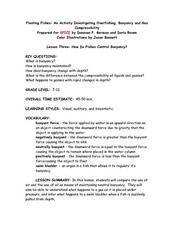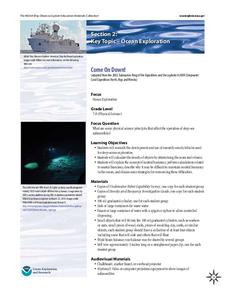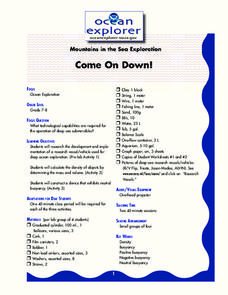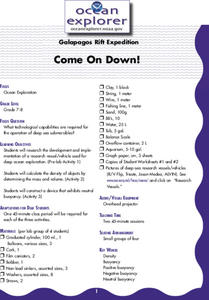Curated OER
Floating Fishes: How do Fishes Control Buoyancy?
Playing with balloons, water, oil, and bottles help put this lesson over the top! Participants use air-filled balloons in water tanks to experience gas compression. They also use oil-filled bottles to experiment with buoyancy. Included...
Florida International University
Simulating Microgravity with Buoyancy
How do astronauts know how to live and work in a weightless environment? It doesn't come naturally! Junior physicists conduct experiments to examine the link between buoyancy and microgravity. Each activity illustrates a different aspect...
California Academy of Science
Buoyancy Bulls-Eye
Why does a seastar sink, but a jellyfish float? Through a fun investigation, learners examine the concept of buoyancy using simple household items. The challenge: create neutral buoyancy for an action figure in water. With ample teacher...
Curated OER
Exploring Buoyancy
Students use materials found at a resource table to design simple devices that will house instruments to take water samples from a tub of water. They design 3 instruments, each varying in density so that one will float, one will hover...
Curated OER
Come On Down!
Begin with an introduction to famous deep-sea submersibles. Learners work in groups to gather information on different vessels and then share with the class. Each group then uses water displacement to help calculate the density of...
Tech Museum of Innovation
Lighter than Air
Scholars participate in two design challenges concerning flight in the second instructional activity of the series. They design balloon crafts that have neutral buoyancy and forward motion.
NOAA
Come on Down!
What do we do when a dive is too dangerous for humans to accomplish? Send in the robots! Middle school scientists get acquainted with several different models of submersible robots in the second lesson of six from NOAA. Lab groups then...
NASA
The NBL Pool
That is a lot of water. Class groups explore the size of the NASA's Neutral Buoyancy Pool and calculate the volume of water needed to fill it. They then compare that volume to the amount of water needed to fill a pool the size of a...
NASA
Newton’s Cool in the Pool
Pupils work together to investigate the cooling of NASA’s Neutral Buoyancy Laboratory. Using data collected as the pool cooled, groups determine the values needed in Newton's Law of Cooling equation to model the situation. They...
Curated OER
Come On Down!
Learners research the implementation of a research vessel used for ocean exploration. In buoyancy lesson students will construct a device that shows neutral buoyancy.
Curated OER
Floating Fishes: Boat Sinking Lab
Cut milk cartons in half to make boats and let investigators attempt to sink them. They add dividing walls and observe what happens if marbles are put into only one of the newly formed compartments. Vocabulary is provided: buoyant force,...
DiscoverE
Pilot a Balloon
Balloons will go where you want them to. Young pilots first add paper clips to a balloon to make it neutrally buoyant. They then use cardboard to steer the balloon in different directions, taking air pressure into account.
Curated OER
Technology of the Deep: Experiments with Buoyant Forces
Students conduct a series of experiments to study the effects of temperature and salinity on the buoyancy of an object in water. They devise ways to make floating and sinking objects neutrally buoyant.
Curated OER
Hitler's Lost Sub
Students watch a video clip about German submarines lost during World War II. They work together to create their own submarine out of a plastic bottle. They test the buoyancy of the submarine in different activities.
Curated OER
Galapagos Rift Expedition Come On Down!
Students research the development and implementation of a research vessel/vehicle used for deep ocean exploration. In this oceanography lesson, students calculate the density of objects by determining the mass and volume.
Curated OER
Submersible Designer
Students work in groups to design, build, and test a submersible prototype. In this engineering lesson, students learn about the importance and design of submersible vessels and apply their knowledge by building one of their own. They...

















